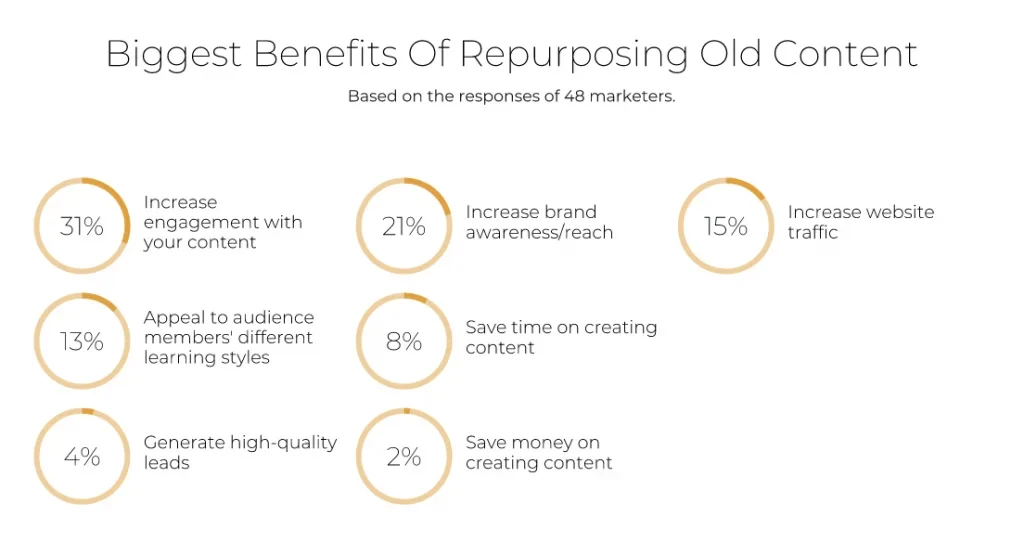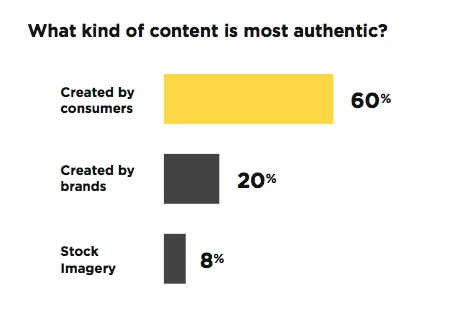How to Repurpose Content for SEO
Who’s to say that content is only good for one post? With the right strategy, a blog, video, or case study can continue to bring traffic long after it’s uploaded.
Wondering how you can benefit from this approach?
In this article, we’ll talk about how to repurpose content for SEO, discussing the advantages of repurposing and some practical tips to help you get started.
What is repurposing content?
Repurposing content is taking old content, transforming it, and representing it online. When repurposing, you might not choose to reuse an entire article, but perhaps just a specific section.
Approaches to repurposing also tend to vary. You might want to present a piece of content in a new format (e.g., transform a blog into a video). Or, you could build on an existing piece of content by changing the writing styles or adding new sections.
Furthermore, you could choose to split an existing article into multiple sections targeting different keywords - even sending some of those articles off to external publishers for PR.
Refreshing content
Repurposing content is different from refreshing content, where you take existing content and an existing keyword to realign and optimize that content for more current search intent.
The benefits of repurposing content
Think about the amount of time it takes to create content. For example, if you’re creating a blog, you need to research, edit, and add media elements before publishing. Keeping up with the need to create regular content is difficult.

Ultimately, if a post works, why just leave it there? Instead of spending time finding the next hit topic, you can continue to reap the rewards of your existing work. Repurposing content is a quick and efficient way of bolstering your SEO.
Alongside time-saving, numerous other benefits can be gained by repurposing content for SEO. Let’s look at some of these advantages.
Create better content
Saving time might boost the quality of your posts. The constant need to churn out more and more content only adds pressure to you and your team. Instead of working to bring value to your audience, you’re focusing on quantity.
Content repurposing buys you a little more breathing room. With more time, you can plan your posts more carefully, and be more likely to create content that lands.
Keyword clustering
A huge ranking factor!
The most effective content is filled with keywords, links, and meta descriptions centered around specific topics. When search engines like Google find this content, they view you as more of an authority on that topic.
The more high-quality content you have focusing on the same topics and keywords, the more SEO-friendly you become and the higher your chances of ranking for that keyword/topic. The right repurposing strategy can help you climb the search engine results page (SERP) and pull in more organic traffic.
Use internal links
Tip: Make sure to internally link to each of the blog posts within a cluster using relevant anchor texts. This is great for keeping users on a site and for creating a readable/crawlable structure for search engines to understand.
Bring new attention to old posts through a refresh
Was an old post particularly successful but isn’t getting attention anymore? Or, do you feel that a low-performing post could do better? In either case, you can bring fresh attention to old posts by repurposing them.
And remember, repurposing doesn’t mean just reusing a post once. If your first attempt doesn’t work, maybe the second or third will. There are plenty of different angles and approaches you can take when repurposing content – experiment until you find one that sticks.
Are you targeting an old, irrelevant keyword?
Your old content may target a keyword that isn’t relevant anymore. In this case, you could target a different keyword and optimize your content for the new, more relevant keyword.
Or you could remove the article, 301 redirect any links and add the content to a bigger article that targets a more relevant keyword, resulting in a more comprehensive article with lots of links!
Reach new audiences on different platforms
On average, people have 7 active social media accounts!
Your content will be uploaded across different platforms, each with a slightly different user base. Repurposing can help you make the most of posts across the platforms you target. For example, a blog on LinkedIn could be translated into a YouTube video.
This way, you expose content to audiences across both platforms and grow your brand further. You might even find that you improve your content more the second time around.
Get the most engagement with different types of content
Across your audience, people consume content in different ways. Some will be visual learners, preferring infographics, case studies, and blog posts. Others will be auditory learners, who will choose podcasts, videos, and webinars.
Translating a post into a different medium helps you meet the varied needs of your audience. Using the best AI video editor allows you to create high-quality video content that enhances audience engagement and retention.
You can make the most of a topic by driving maximum engagement across your user base.
There are great AI tools out there to help you convert existing content into another format. Including text to video!
Tips to help repurpose content for SEO
As we’ve established, there are plenty of benefits to repurposing content. But how can you make sure you’re following the right strategy? Here are some top tips for repurposing content.
Start with goals
As with all content marketing, repurposing should begin with a clear set of goals. Try to be as specific as possible; without a clear destination, your content won’t have the success that you want.
For instance, the goal of ‘boosting organic traffic’ is too broad. All content is designed to attract traffic. Instead, perform a thorough SEO audit and identify a specific set of objectives.
Below are some example goals that you might set for your content repurposing:
- Rank for a specific keyword
- Regain lost standing on a keyword
- Build a following on a certain social media platform
Be sure to assign relevant key performance indicators (KPIs) to your goals to help monitor your progress. If you want to bolster your standing on YouTube, for instance, you might monitor the subscriber count, or use a tool tailored for tracking YouTube rankings.
Tip: High search volume keywords aren’t necessarily the best. Target keywords that your ideal customer will likely search for as part of the conversion funnel.
Evaluate your content
Keeping track of old content is a challenge of SEO but it’s super important to do. I recommend performing a content audit at least once a year. Preferably twice.
Analyze the data. Use Google Search Console and Google Analytics to assess which keywords have dropped in rankings or which pages never drove much traffic to begin with.
When you’ve identified these pages, you should consider:
- Whether to target and optimize for a new keyword, or
- Remove and add to a bigger article, remembering to 301 redirect any links
Always try to follow your audience. What topics do they search for? What leads them to convert? Dig deep into your website analytics. By knowing your audience down to a tee, you’ll be better suited to repurpose content for them.
Consider content types
You’ve identified a post that is a prime candidate for repurposing – great. This doesn’t mean, though, that content will necessarily translate to every format. It’s important to consider compatibility before putting any time and effort into repurposing.
Below are some examples of content that translate well.
- Blog posts to infographics - Take the key highlights from a blog and make them the centerpiece of an infographic. This should include interesting stats, quotes, and other standout features from your blog.
- Long-form content to ebooks - Lengthy blog posts and guides translate nicely into ebooks. These can be offered as freebies for signing up to a mailing list or even sold.
- Written tutorials to video (or vice-versa) - Not everyone in your audience will want to read lengthy tutorials. A step-by-step video can be an effective alternative for certain members of your audience.
Again, take time to think about your audience. What types of content do they tend to consume? There’s no point in repurposing a post into a medium your target audience doesn’t enjoy.
Adapt your approach over time
The best repurposing strategies can adapt over time. Listen to your audience and try to build a data-driven content marketing strategy. If you notice that certain forms of repurposed content are performing better than others, change your focus.
Don’t shy away from negative feedback. Comment sections can be valuable resources. What are people saying about your new posts? If people are responding favorably, or if you’ve sparked a discussion, you’re probably on the right track. If users are negative or not commenting at all, you might need to rethink your tactic.
Don’t forget user-generated content

Content doesn’t always have to come from you directly. User-generated content, like reviews, can be equally useful. User content can come from many different sources. Here are some examples of how it can be used as repurposed content.
- Turn reviews into testimonials - When buyers are considering your products or services, reviews are the first place they tend to look. Why not make their life easier by compiling reviews into a testimonial page?
- Make the most of social media comments - Users will probably have a lot to say on social media. Why not make these posts the basis of some content? For example, you could run an ‘answering audience questions’ feature using social media comments.
- Utilize video reviews and unboxings - Share positive video reviews and unboxings on your site or social media. You could even create a montage of positive reviews (you will need to obtain permission first).
Don’t rely on repurposing
Repurposing content is a useful tactic, but it can only take you so far. Your audience wants content that is original and fresh. They’ll get bored if they see you constantly recycling the same posts.
Not to mention that the well will eventually run dry. You’ll need new content before you can do any more repurposing. Ultimately, repurposed posts should complement your existing output.
Use the extra time saved from repurposing to plan carefully. Creating a content calendar will help you to stay on schedule. Additionally, try to keep your finger on the pulse so that you’re ready to post about new trending topics.
Tools to help with content repurposing
With the right tools, content repurposing can become much easier. There are plenty of solutions that help support your strategy. Let’s explore some of the top examples.
Content Calendar
Just like normal content, you should plan when you repurpose content. A content calendar equips you with the tools to keep track of your deadlines and avoid falling behind schedule. This includes the following features:
- Content tagging - Tag certain areas of campaigns to draw attention or add additional context to assets.
- Customization - Customize your calendar by color coding or altering layouts to your requirements.
- Create groups - Group content that is related to the same marketing campaign or targeted on the same keywords.
Content sharing tools
Once repurposed content is released, your first goal should be to get it in front of your audience. Viral Content Bee is a great mutual content-sharing platform I have used for years. Pick out an email automation software to contact your newsletter list and followers - this will save you hours.
You also should spend time building a good social following by engaging with relevant people and publishing good quality, helpful and unique content. Don’t publish AI water!
Nightwatch’s Rank Tracker
Your goal is to repurpose content for SEO. But how successful are you in climbing the SERP rankings? Nightwatch’s Ranktracker is a tool designed to help you monitor the success of your content. Ranktracker comes with lots of useful features. Below are just a few examples.
- Track keywords - Identify drops in keyword rankings and drops in traffic for specific URLs or pages that are performing well. These are huge indicators as to what content you might want to repurpose.
- Access to any Google Data Center - Gain more granular ranking data by connecting to any data center.
- Create detailed segments - Create specific subsets of users to focus on certain keywords or content groups.
- Rank tracking across different search engines - View search engines ranking for Google, YouTube, Bing, and more.
- Useful integrations - Links with tools like Google Analytics and Google Ads to provide additional data.
Repurposing keeps content alive
As we’ve reflected in this article, repurposed content can be just as reliable as original content. From time and resources saved to greater engagement, repurposing can bring lots of benefits. Of course, you also need the right strategy. Begin with clear goals and outline a roadmap to meeting them. Carefully evaluate your content – remember, not all posts will be candidates for repurposing. Lastly, don’t go it alone. Try to find the right tools that will help support your strategy. Tools like Nightwatch’s Ranktracker can help steer your strategy. Why not see for yourself and try a free 14-day trial?
Author Bio
Will Rice is the SEO & Marketing Manager at MeasureMinds, a leading Google Analytics, Google Tag Manager, PPC, CRO, and SEO agency. He specializes in SEO and content and has helped enterprises achieve #1 rankings for heavily contested keywords through thoughtful strategy and implementation.
